
ALBERTA

Edmonton
NO PART OF THE FOLLOWING
ARTICLE AND PHOTOGRAPHS
MAY BE REPRODUCED WITHOUT
PERMISSION FROM THE AUTHOR ©
(Also referred to as
Exhibition Park, East End Park, and Funland)
This park was next to The Exhibition Grounds in the city. (The first Edmonton Exhibition had started in 1879.) While the exhibition only ran a certain number of weeks during the year, the park was open during all warm months for at least weekends, holidays, and by the request of various groups for special occasions. In 1909, a zoo was established that would last into the 1950s. The park and exhibition proved popular, but little else is known about the early years at this point.
By World War I, the city of Edmonton wished to try to promote business on its street car lines and specifically at the exhibition. The park and fair began to expand so that by the 1920s there were quite a few attractions both permanent and brought in. Little information is available as to what rides or games were there, but they would have changed somewhat with the exhibition midway provider. Tim Covell of Ottawa, Ontario supplied the fact that there was a carousel, dining hall, games tents, an "Old Mill", and a swimming pool.
The first carousel was apparently Philadelphia Toboggan Company model #40. It had 32 horses and 2 chariots spread over three rows. There were a dozen rounding boards and twelve upper and lower panels to match. Johnny Jones was the operator. Later the park would get a permanent unit. A replica of the Jones carousel is currently at The Fort Edmonton Foundation.
|
Borden Park's Midway Circa late 1910s or early 1920s 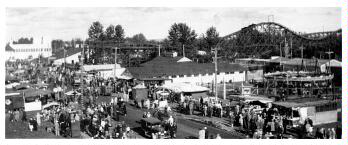
(City of Edmonton Archives: EA 160-688) At the right is an open-top carousel. To its left, the large building is a restaurant (dining hall) and a coaster may be seen in the background. The other structures are not known at this time, but the large white one at Upper Left was an exhibition building. |
During the exhibition, more rides, many side show tents, and various other entertainments were added. One ride appears to be an early version of a Spillman "Ridee-O", which is similar to today's "Himalaya". The photo below shows this. The entertainment on this occasion was a human cannon shot.
|
Exhibition Midway 1931 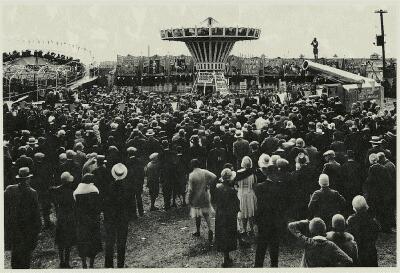
(Glenbow Archives: ND 3-5819) Crowds have gathered to see "Zaccmini" shot from a cannon. At Upper Left there appears to be a Ridee-O, while in the center is an enlarged version of a Chair-O-Plane-style ride. In the background are side show tents featuring The "Human Freak Exhibit". |
Other rides included a ferris wheel and an "Old Mill". The latter was a wet dark ride in which six-passenger boats went through various tunnels drawn along by magnets; so the boats were either metal or had magnetic strips. Various "gags" included skeletons and ghosts which would light up, as triggered by passing boats.
There may have been a "Frolic", but it's unsure if its photos were taken at Borden Park or the exhibition midway. A "Bug House" provided walk-thru or funhouse entertainment.

(Glenbow Archives: ND 6-4480) This midway view shows a carousel, and in the left mid and background, a Frolic and ferris wheel. Note the power poles supplying the midway. Although most rides at this time would still be gasoline powered, some had electric lighting. It is not sure that this photo is in Borden Park itself, but it appears likely. |
The Midway 1919 |
|
The Midway 1919 |
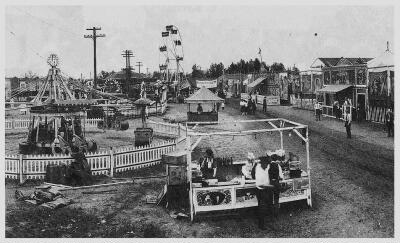
(Glenbow Archives: NE 1-176) In the forground is a food stand selling ice cream and beverages. Note the cable that appears to be running left from the booth's light strings to the overhead power lines above. To the left is a nicely-fenced Frolic ride. Beyond that are a carousel and ferris wheel. The entire area is ringed in side show and game tents. Given that the food concession's light sockets don't all have lamps in them yet, that equipment and supplies are lying around, and that few people are seen, this photo was likely taken on the day of setup for the exhibition midway. |
|
The Midway 1920 |

(Glenbow Archives: NA 4282-2) Here is almost the same view a year later. The Frolic has had light standards and globes added to the fence compared to the previous photo. The building at Center Left background sports a sign saying "Stella", but it's unknown for what that stood. |
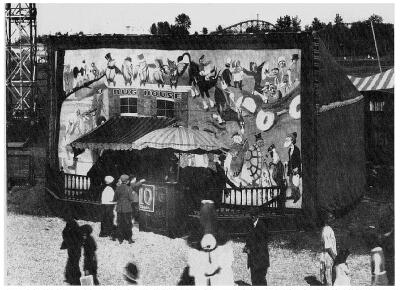
(Glenbow Archives: NA 4282-4) The Bug House was likely a funhouse since the term was slang at the time for "insane asylum". Note the coaster in the far background peaking above the trees. The purpose of the tower at the left is unknown. |
Bug House 1922 |
The park's swimming pool had a bath house and several diving boards. As the years went on, landscaping was added which included shrubs and flower beds, as well as window flower boxes on the bath house.
|
The Bath House Circa 1920s |
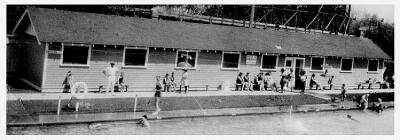
(City of Edmonton Archives: EA 10-2818) |
|
This shows the complete bath house.
It ran nearly the length of the pool.
Beyond the window that is right of the
doorway, is one of the pool's lighting
fixtures. It is hanging over the water
from cable strung the length of the pool.
The life preserver says "Emergency Only". The lack of vegetation is evident compared to the next two pool photos. Other than grass, landscaping had not been done at this point. |
|
The Swimming Pool's Deep End Early 1930s 
(City of Edmonton Archives: EA 160-1002) |
This shows two of the diving boards at the pool. A lower one is behind the higher board seen in the foreground. The object at extreme Upper Left is another of the pools lighting fixtures. |
|
Note the cross-hatching etched into the pool
surrounding deck. This was done to return water
back into the pool that was brought on to the
deck by emerging swimmers. Landscaping has been started by this point. Window flower boxes have been installed and a row of shrubs have been planted against the fence. Just discernable is the netting above the row to give the plants support as they grew. No grounds flower beds are evident yet, though. |
|
The Swimming Pool Early 1930s |
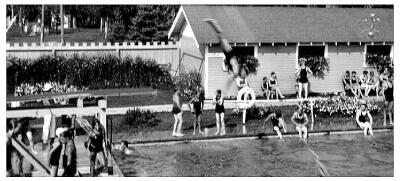
(City of Edmonton Archives: EA 160-749) |
|
A diver has just left the upper board. His
blurred image is seen in front of the
left-most window of the bath house. The grounds landscaping and window boxes are evident in this view. |
An offer was accepted by the city from New York concessionaire Lynn Welcher to place a roller coaster at the site which would straddle the park and exhibition grounds boundary. A percentage of the coaster's revenue would go to the exhibition while it was running, with the percentage going to the street car railway during other times of the season.
Mr. Welcher already had amusement rides at various Canadian and American sites. These included another roller coaster, The "Royal Ascot Racer" erected in Toronto at The Canadian National Exhibition in 1910, possibly as late as 1912. That ride would unfortunately only last until 1919, when it was removed.
The Edmonton coaster was to cost $15,000, with construction to begin in May of 1915 under the direct supervision of Mr. Welcher. The ride location was given a guarantee by the City of Edmonton in the form of a 20-year lease. There seems to be no official name for this coaster, but one source says locals called it The "Green Rattler", so presumably the structure, or at least the rolling stock, was painted green.
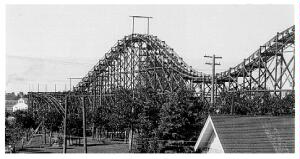
(City of Edmonton Archives: EA 160-1002) Here is a view of the coaster. The lift hill rises from the structure and the track makes a shallow dip, rising to go out of frame to the right. The coaster structure to the left of the lift is for the second turn-around. To extreme Center Left may just be discerned one of the exhibition buildings. The roof at Lower Right is that of the bathing house for the park's swimming pool. |
Green Rattler Lift Hill Circa early 1930s |
|
Green Rattler First Turn-Around Circa early 1930s |
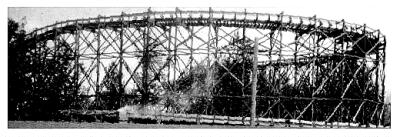
(City of Edmonton Archives: EA 10-2818) This view is to the right of the above but is later in time. It shows the first first turn-around. |
One other ride mentioned for the park in the 1920s was a Parker carousel. No details of it have surfaced but it must have replaced the portable PTC unit brought in by Johnny Jones. It was supposedly in the park from the 1920s through the 1930s. A single surviving horse is presently in the possession of the City of Edmonton Artifacts Centre.
As the 1930s progressed, patronage fell off due to The Depression. The park rides & structures began to deteriorate, so ownership went to the city. The "Old Mill" partially burned and was not worth rebuilding.
Five months before the October 31st end of the roller coaster 0lease period, it was determined that it should be demolished, with the contract being awarded to The Muttart Lumber Company. By July of 1935 it was gone, never having run that season at all. (Note that Tony Cashman's "The Best Edmonton Stories" states it lasted until 1936. 1935 is correct though, as confirmed by letters among the Exhibition Association and various Edmonton city officials.) A fence was then erected to separate Borden Park from The Exhibition Grounds before the start of that season's exhibition on July 15th.
In Tim's references I see that the park has been referred to both as "East End Park" and "Funland" at various times its history. It appears that 1935 may have been the last year of Borden park, although the exhibition apparently went on.
Little else is known about this park. However, Wayne Woodszoo of Edmonton volunteers: "Borden park did not fully close in the 1930s. The zoo on site, which was located near the roller coaster, ran until 1954, and then the park had all of its amusements removed including the zoo. Apparently the exhibition wanted to expand by 11 hectares, essentially cutting into what was left of the park area."
Wayne continues: "A pool was also located near the roller coaster, meaning that the current pool may actually be in the same area where the original was located."
Today, there is a day-use nature area called "Borden Park" in Edmonton that has a swimming pool. It's unclear if it occupies the same property or not. Likely, at least in part, it does.
| Thanks to Tim Covell of Ottawa for the swimming pool and roller coaster photos presented on this page. |
Return to the
Closed Canadian Parks Index
